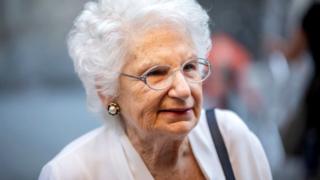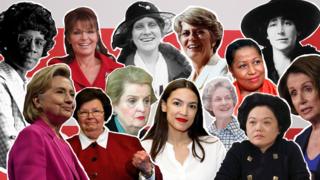 Image copyright
Image copyright
Getty Images
One hundred years ago – on 4 June 1919 – Congress approved the 19th Amendment to the US constitution guaranteeing the right of American women to vote.
The amendment was the product of decades of campaigning and slow progress since the first convention for women’s rights was held in Seneca Falls in 1848.
In the years since, women had been thrown in jail for voting illegally, organised pickets across the country and chained themselves to the White House demanding representation.
Rights were granted in a handful of, mostly western, states over the years but resistance remained. This amendment, officially ratified in 1920, prohibited discrimination on the basis of sex on a national level.
In 2019 the US has more women in national politics than ever before, but still falls well short of equality.
These are the pioneers who have made history in the century since.

First women in congress
Before the amendment, Jeanette Rankin was elected to the House of Representatives in 1916 remarking: “I may be the first woman member of Congress, but I won’t be the last”.
 Image copyright
Image copyright
Bettman via Getty Images
The Montana Republican was a progressive and a committed pacifist
She was a suffragette and lobbyist with the National American Woman Suffrage Association (NAWSA) – an organisation borne out of the frustration over post-civil war reconstruction not advocating for women’s rights.
She voted against US entry into World War One – a move that would eventually cost her her seat. She then returned to the House in 1940 on an anti-war platform – becoming the only member to vote against US entry in both conflicts.
In 1922 Rebecca Latimer Felton became the first woman to serve in the US Senate – but only as a symbolic gesture for 24 hours. Ten years later Hattie Ophelia Caraway, from Arkansas, became the first woman ever elected to the chamber.
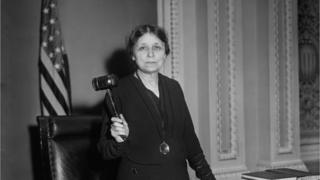 Image copyright
Image copyright
Universal History Archive via Getty
Caraway was also the first woman to serve as a committee chairman
Her husband, Thaddeus, had died in office the year before and a governor had chosen her to fill his seat drawing on something known as the “widow’s mandate”.
She then won a special election to serve out the rest of his term and achieved re-election herself in 1938.
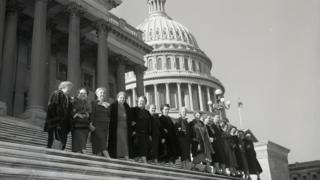 Image copyright
Image copyright
Bettmann via Getty
The women serving in the 84th Congress – in 1955 – pose on the Capitol steps
In spite of the 19th Amendment, racially-targeted voter suppression and disenfranchisement remained a problem throughout the 20th Century.
Hawaii representative Patsy Mink became the first woman of colour, and first Asian-American woman, to be elected to the House in 1964.
Four years later Shirley Chisholm became the first African-American congresswoman. Born in Brooklyn, she served seven terms and became known as “Fighting Shirley” because of her reputation as a champion of racial and gender equality.
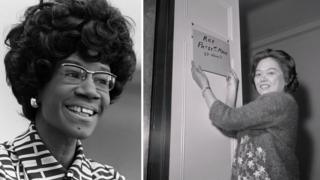 Image copyright
Image copyright
Getty Images
Chisholm and Mink would both eventually make primary bids for president too
First female governor
In 1925, Nellie Tayloe Ross became the first woman to ever hold a US governor post – elected after the death of her husband.
Wyoming, where she served, was the first territory in the US to offer suffrage to women – back in 1869.
Despite failing to win re-election, Ross remained in politics and moved to Washington DC.
 Image copyright
Image copyright
Bettman via Getty
In 1933 Ross was appointed by Franklin D Roosevelt as the first female director of the US Mint
First women to lead political parties
Utah-born Jean Westwood became the first ever woman to chair a political party in 1972 – the same year Congress approved the Equal Rights Amendment.
The New York Times reported that when she expressed her pride at becoming chairman of the Democratic National Committee she was heckled by audience members saying she should be a chairwoman or chairperson instead.
“I’m proud to be your chairman,” she reiterated and the matter was settled, according to the newspaper.
The Republican party followed two years later, when Mary Louise Smith succeeded future president George HW Bush as their chair.
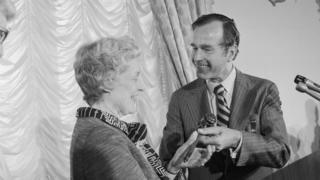 Image copyright
Image copyright
Bettmann via Getty
Smith was also the last woman to serve as the party’s chair until 2017
She was a political moderate and took over in the midst of the party’s recovery from the Watergate scandal.
First female Supreme Court justice
Of the 114 Supreme Court justices in US history – a staggering 110 have been men.
The first woman to be nominated to the top court was Sandra Day O’Connor – on the back of a 1980 election campaign pledge by Ronald Reagan.
 Image copyright
Image copyright
Corbis via Getty
O’Connor served on the court until she retired in 2006
O’Connor was from Arizona and was unanimously confirmed at a 1981 Senate vote.
She was followed in 1993 by Ruth Bader Ginsburg, nominated by Bill Clinton.
President Obama nominated two more women to the Supreme Court – Sonia Sotomayor and Elena Kagan.
First female attorney general
President Bill Clinton chose Janet Reno to lead the US Justice Department in 1993.
As Attorney General, she oversaw some of the most notorious events in US history including the Waco siege and the Oklahoma City bombing.
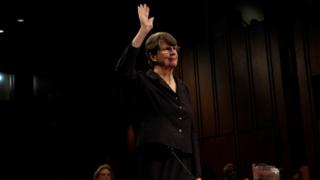 Image copyright
Image copyright
Getty Images
Born in Miami, Florida – she had extensive criminal prosecution experience before being nominated
During her tenure, she received a lot of media scrutiny about her physical appearance, especially her 6ft 1in frame.
She was portrayed by actor Will Ferrell on Saturday Night Live – but turned the joke around in 2006 when she appeared alongside him in a sketch.
First female secretary of state
President Clinton also nominated the first female secretary of state in US History – Madeleine Albright.
Born Marie Jana Korbel in then-Czechoslovakia, her family fled to England when the Nazis invaded. Her father was also a diplomat and negotiated their refuge into the US after the war.
Having previously worked under Jimmy Carter’s National Security Advisor Zbigniew Brezensinki, Ms Albright was named as US ambassador to the UN in 1993.
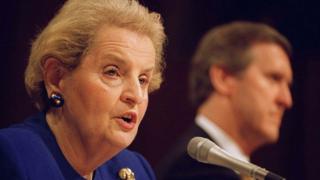 Image copyright
Image copyright
Getty Images
Albright advocated for an increased US role on the international stage
As secretary of state, from 1997 to 2001, she became known for her firm commitment to human rights.
In 2005, Condoleezza Rice became the second woman, and first African-American woman, to hold the post.
First female speaker
The incumbent speaker of the House of Representatives is also the first, and only, woman to hold the role.
Nancy Pelosi, 79, has led the Democrats in the lower house since 2003, and first became the speaker in 2007.
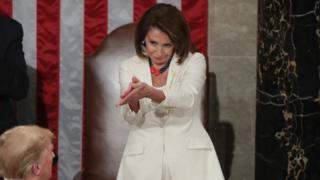 Image copyright
Image copyright
Getty Images
The role means Pelosi, as second in presidential line of succession, is the highest-ranking elected woman in US history
Following the 2018 mid-term results, she returned to the position and is spearheading congressional opposition to President Trump.
She comes from a family heavily involved in politics, with both her father and brother serving as mayor of Baltimore.
Ms Pelosi herself rose up the party ranks in California, where she lived with her family – serving as DNC rep for the state from the 1970s before making the leap into national public office in 1987.
Most women in congress
The amount of women in Congress has been steadily on the rise since the early 1990s – but the record amount of 127 at present still sits far short of parity.
Today, only about 25% of national lawmakers are women.
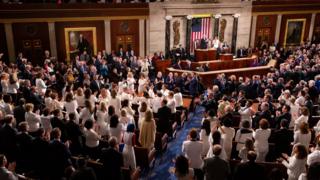 Image copyright
Image copyright
Getty Images
Female Democrats at the State of the Union wear white to celebrate their numbers
Nevertheless, the 116th Congress has received widespread praised for its progressive representation.
Notable firsts include the youngest member of Congress elected ever – Alexandria Ocasio Cortez.
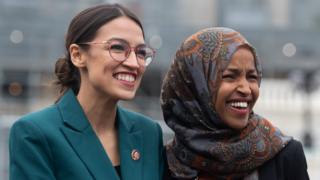 Image copyright
Image copyright
Getty Images
The latest Congress has been praised for its diversity – including young and minority congresswomen
The 2018 success, in the midst of the #MeToo movement, drew comparisons to the previous “Year of the Woman” in 1992. In that year, the total amount of women jumped from 32 to 54 in one vote.
Many linked the female success rate to high-profile sexual misconduct cases playing out in public at that time – including Clarence Thomas being confirmed to the Supreme Court despite allegations of harassment lodged by Anita Hill.
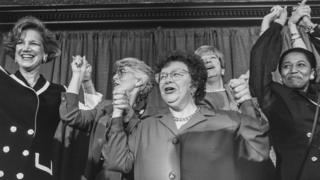 Image copyright
Image copyright
Getty Images
National Women in Politics Caucus, formed in 1971, celebrate female victories in 1992
That year six women were elected to the Senate – at a time when they did not even yet have a designated female bathroom nearby.
Potty parity, as it has come to be known, is considered a key marker of institutional misogyny. It took until 2011 for the House of Representatives to get a female restroom nearby to the voting floor.
It wasn’t until the 1990s for old-fashioned attitudes about congresswomen’s appearance to change too.
On one weekend in 1993, Barbara Mikulski – the longest serving female lawmaker ever – plotted a “pantsuit” protest against how women were expected to wear skirts.
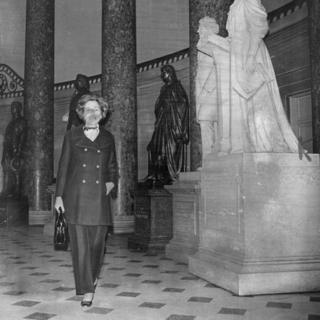 Image copyright
Image copyright
The Washington Post via Getty
In 1969 Republican Charlotte T Reid caused a scandal when she turned up to the House floor in a “black wool, bell-bottomed pantsuit”
She and Senator Nancy Kassebaum told female staffers to show up to Congress in trousers – a move that apparently prompted “a big stir” but ultimately helped break the norm.
First women on a presidential ticket
Geraldine Ferraro was the first woman to ever be on a major party’s presidential ticket, chosen as running mate for Democratic candidate Walter Mondale in the 1984 election.
Unfortunately for them both, Mondale lost heavily to Republican Ronald Reagan – who came out in top in 49 of 50 states.
 Image copyright
Image copyright
Getty Images
Ferraro was a New York Representative and had a background as a teacher and a lawyer
Sarah Palin became the first Republican vice-presidential nominee in 2008. The late Senator John McCain was the lead candidate on the ticket – but they lost to Barack Obama and his running mate Joe Biden.
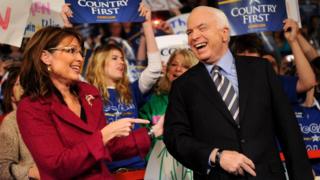 Image copyright
Image copyright
AFP
Palin was also Alaska’s first female gorvenor
So far no woman has served as vice-president of the United States.
First female president?
Of course, the dream of a female US president is still also unfulfilled.
Well before Hillary Clinton, other women had also put themselves forward for the top office.
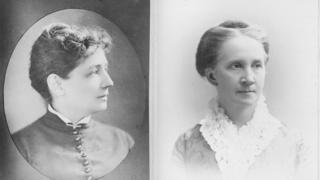 Image copyright
Image copyright
Getty Images
Victoria Woodhull (left) and Belva Ann Lockwood ran for Equal Rights Party in 1972 and 1884 respectively
Among them was Margaret Chase Smith, a pioneer against McCarthyism who ran for the Republican nomination in the 1964 presidential race.
Her candidacy spurned sexist news coverage including an undue focus on her appearance and age that male candidates avoided.
She was largely without campaign financing – and lost all her primaries – but nonetheless became the first to have her name on the ballot at a major party’s convention.
“When people keep telling you, you can’t do a thing, you kind of like to try,” she said.
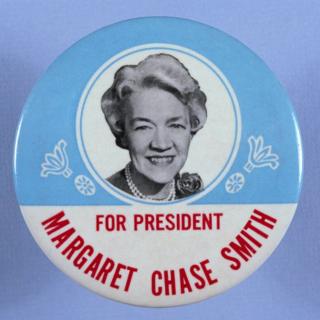 Image copyright
Image copyright
Corbis via Getty
Smith ran against Barry Goldwater, and was also the first woman to serve in both chambers of Congress
Others, including the first African-American Senator Carol Moseley Braun, also failed in their nomination attempts after this.
It took until Hillary Clinton‘s primary victory in 2016 for a woman to eventually win a major party’s candidacy.
Clinton already had an impressive public office pedigree – in 2001 becoming the first former first lady to win a political seat of her own.
 Image copyright
Image copyright
Getty Images
Clinton was senator of New York from 2001 to 2009
She had ran for the Democratic nomination in 2008 but conceded to Barack Obama, before serving as his secretary of state from 2009 to 2013.
On 8 November 2016, the date women could vote for a female president for the first time, many travelled to suffragette graves to leave “I voted” stickers.
 Image copyright
Image copyright
Reuters
Susan B Anthony’s grave, in Rochester NY, photographed on 2016 election day
However, in a massive political upset, Clinton lost. She had edged the popular vote overall, but lost the electoral college.
Key swing states, including Florida and Pennsylvania, flipped to Donald Trump and the Republican party – dashing hopes of a female president.
Ahead of the 2020 presidential election Democrats are now lining up to take on President Trump.
This includes six women who have already announced their candidacy – a new record in itself.
Whether or not this means the US may eventually get its first female president, a century on from the 19th Amendment’s ratification, time will tell.
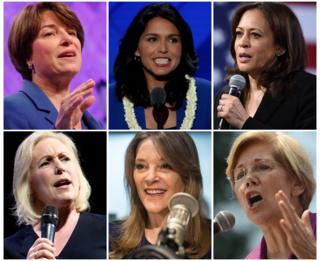 Image copyright
Image copyright
Getty Images
From top left to bottom right: Amy Klobuchar, Tulsi Gabbard, Kamala Harris, Kirsten Gillibrand, Marianne Williamson, Elizabeth Warren
Reporting by Kelly-Leigh Cooper. All images subject to copyright





